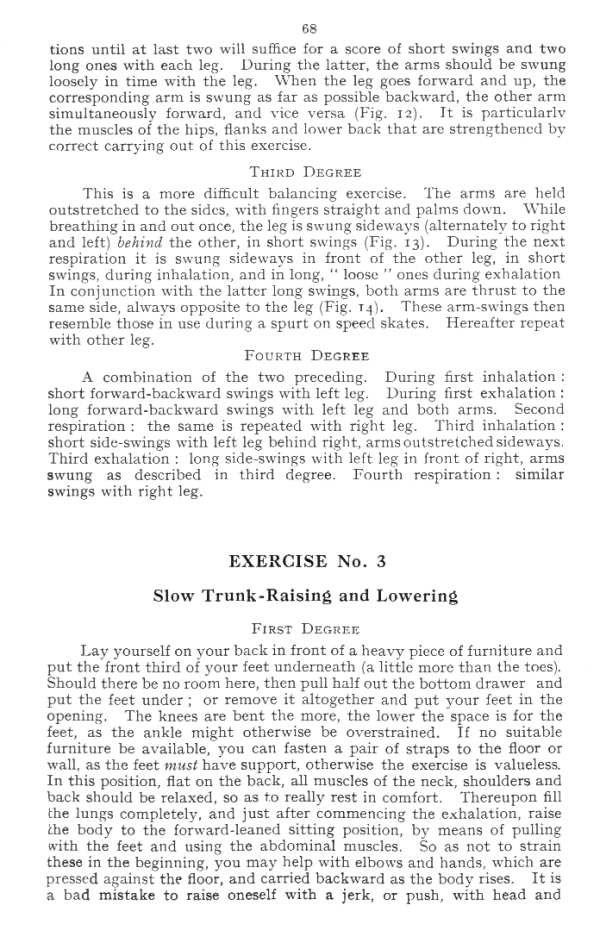system 68

68
tions until at last two will suffice for a score of short swings and two long ones with each leg. During tlie latter, tbe arms should be swung looscly in time with the leg. When the leg goes forward and up, the corresponding arm is swung as far as possible backward, the other ann simultaneously forward, and vice versa (Fig. |g). It is particularh’ the muscles of the liips, flanks and lower back that arc strengthencd by correct carrying out of this exercisc.
Third Degree
This is a morę dii&cult balancing excrcise. The arms are lield outstretched to the sidcs, with lingers straight and palms down. While breathmg in and out oncc, the leg is swung sideways (alternately to right and left) behimi the other, in short swings (Fig. 13). During the next respiration it is swung sideways in front of the other leg, in short swings, during inhalation, and in long, " loose " ones during exhalation In conjunction with the latter long swings, botli arms are thrust to the same side, always opposite to the leg (Fig. 1^). These arm-swings then resemblc those in use during a spurt on speed skates. Hereafter rcpeat with other leg.
Fourth Degree
A combination of the two preceding. During first inhalation : short forward-backward swings with left leg. During first exhalation : long forward-backward swings with left leg and both arms. Second respiration : the same is repeated with right leg. Third inhalation : short side-swings with left leg behind right. arms outstretched sideways. Third exhalation : long side-swings with left leg in front of right, arms swung as described in third degree. Fourth respiration: similar swings with right leg.
EXERCISE No. 3 Slow Trunk-Raising and Lowering
First Degree
Eay yourself on your back in front of a heavy piece of furniture and put the front third of your feet underneath (a little morę than the toes). Should there be no room here, then puli half out the bottom drawer and put the feet under; or remove it altogether and put your feet in the opening. The knees are bent the morę, the lower the space is for the feet, as the ankle might otherwise be overstrained. If no suitable furniture be available, you can fasten a pair of straps to the fioor or wali, as the feet musi bave support, otherwise the exercise is valtieless. In this position, flat on the back, all muscles of the neck, shoulders and back should be relaxed, so as to really rest in comfort. Thereupon fili the lungs completely, and just after commencing the cxhalation, raise the body to the forward-leaned sitting position, by means of pulling with the feet and using the abdominal muscles. So as not to strain these in the beginning, you may help with elhows and hands. which are pressed against the fioor, and carried backward as the body rises. It is a bad mistake to raise oneself with a jerk, or push. with head and
Wyszukiwarka
Podobne podstrony:
69626 mbs 116 MY BRF.ATHING SYSTEM featliering) will, in most cases, last j ust as long as two strid
77798 Yanni Live At The?ropolis DVD front SANTOKU 2. KEYS TO IMAGINATiON 3. UNTIL THE LAST MOMBI
Yanni Live At The?ropolis DVD Back i.SANTORINI 2. KEYS TO IMAGINATION 3. UNTIL THE LAST MOMENT 4
page70 (J?.2 266~68 J 1±±ti<0?}& 66~68BS«3.8cmS85cm 66 7b7.b y
f7 2 UNIX(r) System U Release 4.0 (huka) login: brienna Password: Last login: Wed Jun 26 15:40:45 fr
Now tor the tirst time! SOLDER ALUMINUM EASILY, INEXPENSIVELY with Reynolds new soldering brush kit
17. What is the West of London famous for? 18. Name at least two famous football clubs in London? 19
więcej podobnych podstron